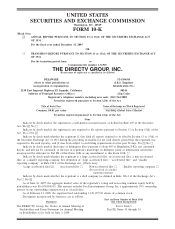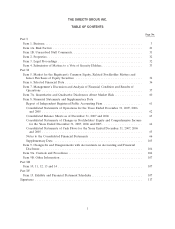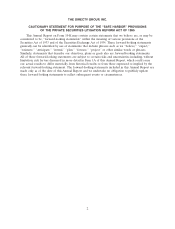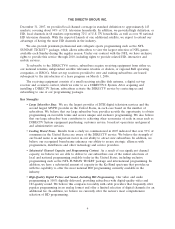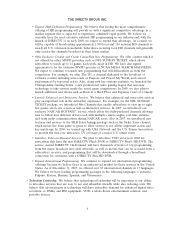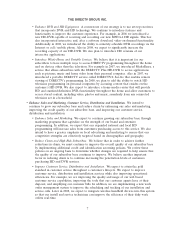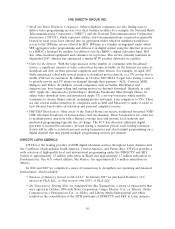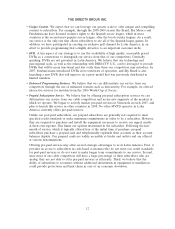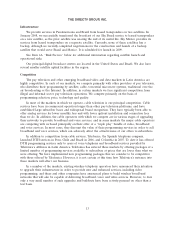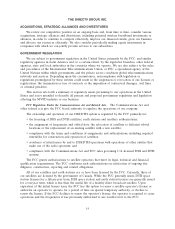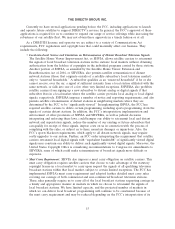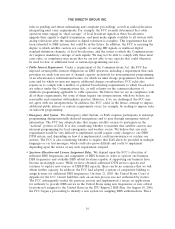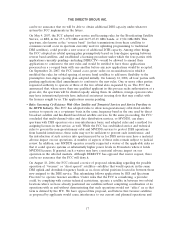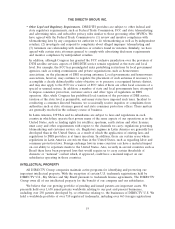DIRECTV 2007 Annual Report Download - page 18
Download and view the complete annual report
Please find page 18 of the 2007 DIRECTV annual report below. You can navigate through the pages in the report by either clicking on the pages listed below, or by using the keyword search tool below to find specific information within the annual report.THE DIRECTV GROUP, INC.
Operating Corporation and N.E.W. Customer Service Companies, Inc. We currently operate five
customer service centers located in: Boise, Idaho; Tulsa, Oklahoma; Huntsville, Alabama; Missoula,
Montana; and Denver, Colorado that employ approximately 4,700 customer service representatives.
Potential and existing subscribers can call a single telephone number 24 hours a day, seven days a
week, to request assistance for hardware, programming, installation, technical and other support. We
continue to increase the functionality of telephone-based and web-based self-care features in order to
better manage customer service costs and improve service levels.
Competition
We face substantial competition in the MVPD industry and from emerging digital media
distribution providers. Our competition includes companies that offer video, audio, interactive
programming, telephony, data and other entertainment services, including cable television, other DTH
companies, RBOCs, wireless companies and companies that are developing new technologies. Many of
our competitors have access to substantially greater financial and marketing resources. We believe our
brand, the quality and variety of video, audio and interactive programming, quality of picture, access to
service, availability of HD and DVR services, customer service and price are the key elements for
attaining and retaining subscribers. According to the National Cable & Telecommunications
Association’s Mid-Year 2007 Industry Overview, 100% of the U.S. television households are passed by
cable. Our 16.8 million subscribers represent approximately 17% of MVPD subscribers.
•Cable Television. We encounter substantial competition in the MVPD industry from cable
television companies. Most cable television operators have a large, established customer base,
and many have significant investments in companies that provide programming content. Of the
112 million U.S. television households, approximately 97 million subscribe to a MVPD service
and approximately 66% of MVPD subscribers receive their programming from a cable operator.
In addition, most cable providers have completed network upgrades that allow for enhanced
service offerings such as digital cable, HD local channels, broadband Internet access and
telephony services. Cable companies bundle these services, offering discounts and providing one
bill to the consumer.
•Other Direct Broadcast Satellite and Direct-To-Home Satellite System Operators. We also compete
with Dish Network Corporation, which had over 13 million subscribers at the end of 2007,
representing approximately 14% of MVPD subscribers. Other domestic and foreign satellite
operators also have proposed to offer DTH satellite service to U.S. customers using U.S.-
licensed satellite frequencies or foreign-licensed frequencies that have the ability of covering the
United States.
•Regional Bell Operating Companies. Several RBOCs have started to upgrade their infrastructure
by replacing their older copper wire telephone lines with high-speed fiber optic lines. These fiber
lines provide the RBOCs with significantly greater capacity enabling them to offer new and
enhanced services, such as Internet access at much greater speeds and video. For example,
Verizon announced that at the end of 2007, it had the capability to serve nine million homes
with fiber optic lines with the goal of having the capability to serve 18 million homes by the end
of 2010. In addition, AT&T Inc. has begun deploying fiber optic lines to neighborhoods and
expects to have the capability to serve approximately 30 million of its customers by 2010. Similar
to the cable companies, the RBOCs expect to offer their customers multiple services at a
discount on one bill. In addition, AT&T recently acquired BellSouth Corporation, and
announced that it would decide at the end of 2008 which DBS service it would sell along with its
telephony and DSL business. See Item 1A. ‘‘Risk Factors’’ for more information.
9



